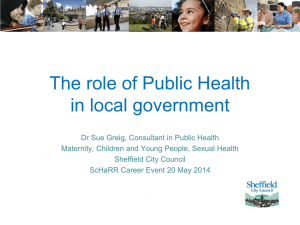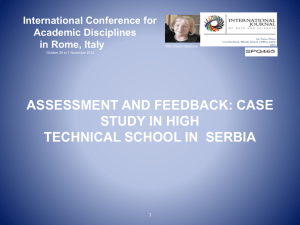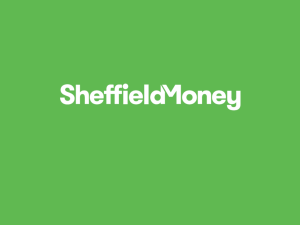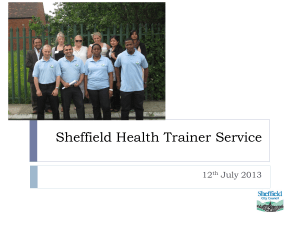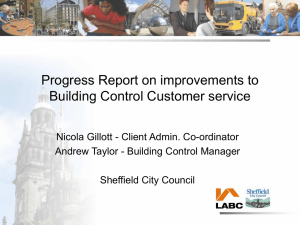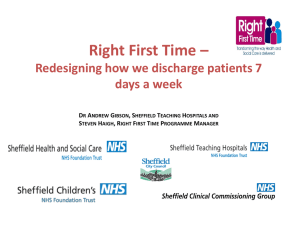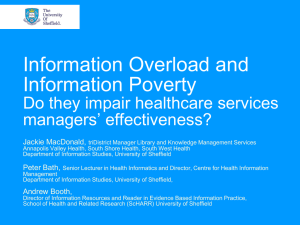Powerpoint slides
advertisement
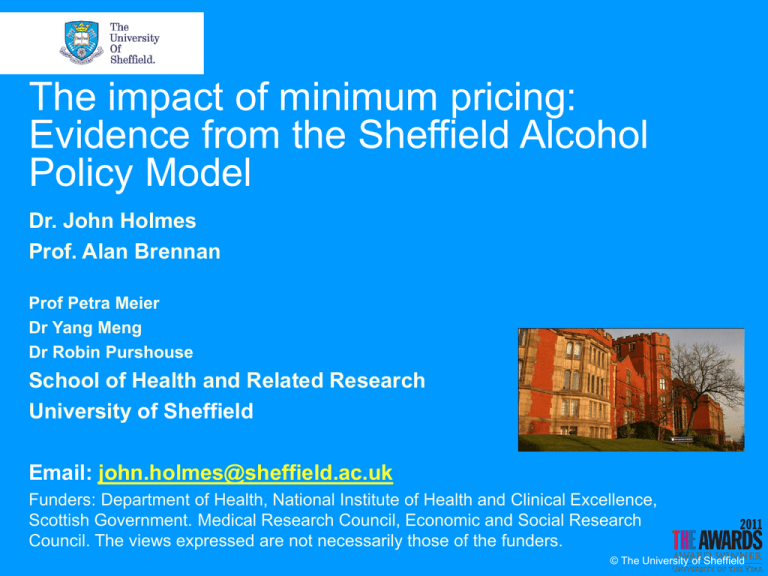
The impact of minimum pricing: Evidence from the Sheffield Alcohol Policy Model Dr. John Holmes Prof. Alan Brennan Prof Petra Meier Dr Yang Meng Dr Robin Purshouse School of Health and Related Research University of Sheffield Email: john.holmes@sheffield.ac.uk Funders: Department of Health, National Institute of Health and Clinical Excellence, Scottish Government. Medical Research Council, Economic and Social Research Council. The views expressed are not necessarily those of the funders. © The University of Sheffield THE SHEFFIELD ALCOHOL POLICY MODEL Introduction to the model • Appraises the effectiveness and costeffectiveness of alcohol policies • Pricing policies examined for Scotland: • Minimum prices from 25p to 70p per unit • Total off-trade discount ban (not multibuy) • Minimum price + off-trade discount ban Introduction to the model • Provides estimates of: • Changes in consumption • Changes in levels of harm Health Crime Workplace • Changes in the cost of harms • Changes in consumer spending • Change in revenue to the exchequer Structure and evidence base • 2-stage model: • Price change to consumption change • Consumption change to rates of alcohol-related harm • Price to consumption: • Econometric analysis to generate price elasticities • Based on UK data on individuals’ spending and alcohol prices • Consumption to harm: • Uses risk functions and alcohol attribution levels • Based on best available published evidence • Scotland adaptations: • Uses Scottish data where available (see reports for details) 1 unit = 10ml of pure ethanol Beer (4% ABV) 1 pint ≈ 2 units Wine (12% ABV) 175ml glass ≈ 2 units 750ml bottle ≈ 9 units Whiskey (40% ABV) 25ml measure ≈ 1 unit Units per week Drinker type Moderate Hazardous Harmful Men Women Less than 21 Less than 14 21 – 50 14 – 35 50+ 35+ THE KEY EVIDENCE Effects of Price on Alcohol Consumption: A meta-analysis of 112 studies Found significant effects for: - Total alcohol & individual beverages - Younger & older drinkers - Moderate & binge drinkers Example: Average effect of a price increase on the consumption of all beverages Source: Wagenaar et al. (2009) ‘Effects of beverage alcohol tax and price levels on drinking: a metaanalysis of 1003 estimates from 112 studies’. Addiction, 104, pp.179-90 Conclusions - Morbidity & Mortality • Doubling the alcohol price was associated with – 35% reduction in alcohol-related mortality – 11% reduction in traffic crash deaths – 6% reduction in sexually transmitted diseases – 2% reduction in violence – 1% reduction in crime Source: Wagenaar et al. (2010) ‘Effects of alcohol tax and price policies on morbidity and mortality: A systematic review’, American Journal of Public Health, 100(11), pp.2270-8 Average price paid per unit of alcohol in England Source: Analysis of Expenditure and Food Survey 2005/6 Recent Canadian evidence • Different minimum price policies in different provinces • Beverage-specific price per unit • Beverage-specific minimum price • Studies conducted in BC and Saskatchewan • When minimum prices are increased by 10%, consumption falls by: • 8% in Saskatchewan • 3.4% in BC Sources: Stockwell et al.(2012) ‘Does minimum pricing reduce alcohol consumption? The experience of a Canadian province’, Addiction, 107, pp.912-20 Stockwell et al.(2012) ‘The raising of minimum alcohol prices in Saskatchewan, Canada: Impacts on consumption and implications for public health’, American Journal of Public Health, doi:10.2105/AJPH.2012.301094 THE FINDINGS Price policy effects: % change in consumption Estimated effects of minimum pricing 50p minimum price per unit Overall reduction in consumption 5.7% Annual health savings in year 10 Deaths 318 Hospital admissions 6,500 Annual savings Crimes 3,500 Days absent 32,300 Unemployed persons 1,300 10 year cost reduction Health £114m (direct) £492m (QALY) Crime £24m (direct) £20m (QALY) Work £292m Total £942m Revenue changes Retailers +£68.3m (off) +£29.3m (on) Duty + VAT -£20.6m (off) +£10.1m (on) Price policy effects on drinker types’ consumption in England 20.0% Reduction in consumption 16.4% 16.0% 11.6% 11.7% 12.0% 10.9% 10.1% 8.8% 7.4% 8.0% 4.0% 5.4% 4.5% 4.5% 3.5% 4.4% 3.8% 1.2%1.4% 0.0% 10% 25% 40p General price increase Moderate 50p Minimum unit price Hazardous Source: http://guidance.nice.org.uk/PHG/21/EconomicModellingReport/pdf/English Harmful 60p The cost of minimum pricing to drinkers For further information • John.holmes@sheffield.ac.uk • http://www.shef.ac.uk/scharr/sections/ph/research/alpol • Unless otherwise indicated, all figures in this presentation are taken from: Meng, Y. et al. (2012) 'Model-based appraisal of alcohol minimum pricing and off-licensed trade discount bans in Scotland using the Sheffield Alcohol Policy Model (v.2): Second update based on newly available data' ScHARR, University of Sheffield
